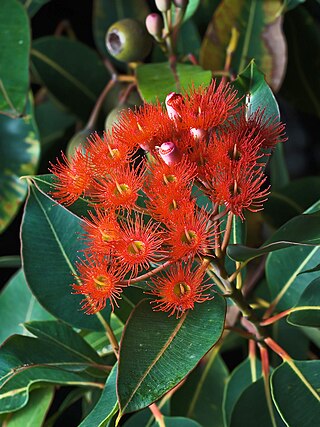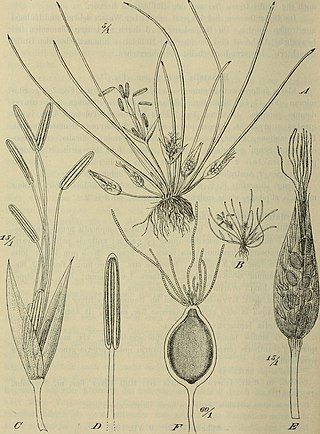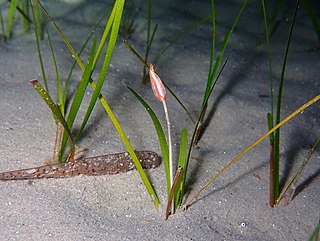
Corymbia ficifolia, commonly known as red flowering gum, is a species of small tree that is endemic to the south-west of Western Australia. It has rough, fibrous bark on the trunk and branches, egg-shaped to broadly lance-shape adult leaves, flower buds in groups of seven, bright red, pink or orange flowers and urn-shaped fruit. It has a restricted distribution in the wild but is one of the most commonly planted ornamental eucalypts.

Seagrasses are the only flowering plants which grow in marine environments. There are about 60 species of fully marine seagrasses which belong to four families, all in the order Alismatales. Seagrasses evolved from terrestrial plants which recolonised the ocean 70 to 100 million years ago.

Zosteraceae is a family of marine perennial flowering plants found in temperate and subtropical coastal waters, with the highest diversity located around Korea and Japan. Most seagrasses complete their entire life cycle under water, having filamentous pollen especially adapted to dispersion in an aquatic environment and ribbon-like leaves that lack stomata. Seagrasses are herbaceous and have prominent creeping rhizomes. A distinctive characteristic of the family is the presence of characteristic retinacules, which are present in all species except members of Zostera subgenus Zostera.

Banksia ilicifolia, commonly known as holly-leaved banksia, is a tree in the family Proteaceae. Endemic to southwest Western Australia, it belongs to Banksia subg. Isostylis, a subgenus of three closely related Banksia species with inflorescences that are dome-shaped heads rather than characteristic Banksia flower spikes. It is generally a tree up to 10 metres (33 ft) tall with a columnar or irregular habit. Both the scientific and common names arise from the similarity of its foliage to that of the English holly Ilex aquifolium; the glossy green leaves generally have very prickly serrated margins, although some plants lack toothed leaves. The inflorescences are initially yellow but become red-tinged with maturity; this acts as a signal to alert birds that the flowers have opened and nectar is available.

Ruppia, also known as the widgeonweeds, ditch grasses or widgeon grass, is the only extant genus in the family Ruppiaceae, with eight known species. These are aquatic plants widespread over much of the world. The genus name honours Heinrich Bernhard Rupp, a German botanist (1688-1719). They are widespread outside of frigid zones and the tropics.

Hydatellaceae are a family of small, aquatic flowering plants. The family consists of tiny, relatively simple plants occurring in Australasia and India. It was formerly considered to be related to the grasses and sedges, but has been reassigned to the order Nymphaeales as a result of DNA and morphological analyses showing that it represents one of the earliest groups to split off in flowering-plant phylogeny, rather than having a close relationship to monocots, which it bears a superficial resemblance to due to convergent evolution. The family includes only the genus Trithuria, which has at least 13 species, although species diversity in the family has probably been substantially underestimated.

Banksia menziesii, commonly known as firewood banksia, is a species of flowering plant in the genus Banksia. It is a gnarled tree up to 10 m (33 ft) tall, or a lower spreading 1–3 m (3.3–9.8 ft) shrub in the more northern parts of its range. The serrated leaves are dull green with new growth a paler grey green. The prominent autumn and winter inflorescences are often two-coloured red or pink and yellow, and their colour has given rise to more unusual common names such as port wine banksia and strawberry banksia. Yellow blooms are rarely seen.
Amphibolis antarctica is a species of flowering plant in the family Cymodoceaceae. It is referred to by the common names wire weed or sea nymph, and is a seagrass found in coastal waters of southern and western Australia.
Western Australia has the longest coastline of any state or territory in Australia, at 10,194 km or 12,889 km. It is a significant portion of the coastline of Australia, which is 35,877 km.

Posidonia australis, also known as fibre-ball weed or ribbon weed, is a species of seagrass that occurs in the southern waters of Australia. It forms large meadows important to environmental conservation. Balls of decomposing detritus from the foliage are found along nearby shore-lines.
Posidonia ostenfeldii is a species of seagrass that occurs in the southern waters of Australia.

Posidonia is a genus of flowering plants. It contains nine species of marine plants ("seagrass"), found in the seas of the Mediterranean and around the south coast of Australia.

Posidonia oceanica, commonly known as Neptune grass or Mediterranean tapeweed, is a seagrass species that is endemic to the Mediterranean Sea. It forms large underwater meadows that are an important part of the ecosystem. The fruit is free floating and known in Italy as "the olive of the sea". Balls of fibrous material from its foliage, known as egagropili or Neptune balls, wash up to nearby shorelines.

Althenia is a genus of aquatic plants of the family Potamogetonaceae. This has long been a group of two species in the Mediterranean Europe and South Africa, but in 2016 was revised to include an Australasian relative, Lepilaena.
Posidonia coriacea is a species of seagrass that occurs in the southern waters of Australia.
The Seagrasses of Western Australia are submerged flowering plants found along the coast, around islands, and in Estuaries of Western Australia. The region contains some of the largest seagrass meadows in the world, and is the most diverse in the number of species. The variety of habitats along its western and southern coasts is often soft sands in shallow subtropical waters, ideal for these plants.

Adenanthos obovatus, commonly known as basket flower, or, jugflower, is a shrub of the plant family Proteaceae endemic to Southwest Australia. Described by French naturalist Jacques Labillardière in 1805, it had first been collected by Archibald Menzies in 1791. Within the genus Adenanthos, it lies in the section Eurylaema and is most closely related to A. barbiger. A. obovatus has hybridized with A. detmoldii to produce the hybrid A. × pamela. Several common names allude to the prominent red flowers of the species. It grows as a many-stemmed spreading bush up to 1 m (3.3 ft) high, and about 1.5 m (4.9 ft) across, with fine bright green foliage. Made up of single red flowers, the inflorescences appear from April to December, and peak in spring.

Thalassia testudinum, commonly known as turtlegrass, is a species of marine seagrass. It forms meadows in shallow sandy or muddy locations in the Caribbean Sea and the Gulf of Mexico. Turtle grass and other seagrasses form meadows which are important habitats and feeding grounds. The grass is eaten by turtles and herbivorous fish, supports many epiphytes, and provides habitat for juvenile fish and many invertebrate taxa.

Cymodocea nodosa is a species of seagrass in the family Cymodoceaceae and is sometimes known as little Neptune grass. As a seagrass, it is restricted to growing underwater and is found in shallow parts of the Mediterranean Sea and certain adjoining areas of the Atlantic Ocean.

Potamogeton tepperi is a water herb, belonging to the Potamogetonaceae family in the order Alismatales.













